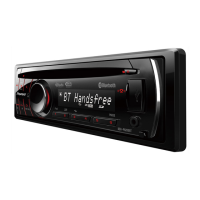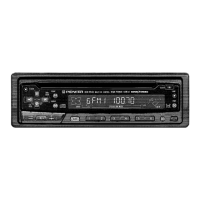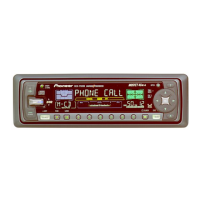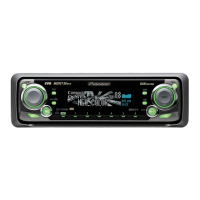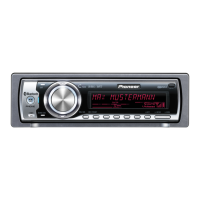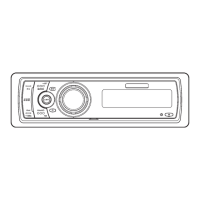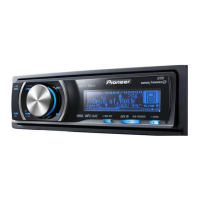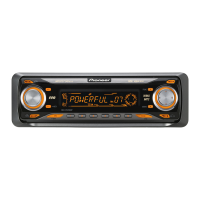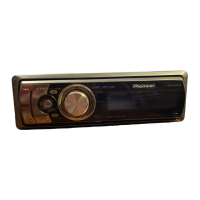
Do you have a question about the Pioneer DEH-P6200BT and is the answer not in the manual?
| Model | DEH-P6200BT |
|---|---|
| Peak Output | 50 Watts |
| RMS Power Output Per Channel | 22 Watts |
| Peak Power Output Per Channel | 50 Watts |
| Subwoofer Preamp Output | Yes |
| Bluetooth Compatibility | Yes |
| CD Playback | Yes |
| iPod Compatibility | Yes |
| USB Input | Yes |
| AUX Input | Yes |
| Radio Tuner | AM/FM |
| Presets | 24 |
| Detachable Face | Yes |
| Memory Card Reader | No |
| HD Radio | No |
| Satellite Radio Ready | Yes |
| Navigation | No |
| Remote Control | Yes |
| Face Color | Black |
| CD Text | Yes |
| MP3/WMA Text Information | Yes |
| DIN Size | 1 DIN |
| Power Output | 50 Watts x 4 |
| RMS Power Output | 22W RMS x 4 |
| Preamp Voltage | 4 Volts |
| Preamp Outputs | 3 pairs (Front/Rear/Subwoofer) |
| Display Type | LCD |
| EQ | 13-Band Graphic EQ |
Provides essential user information about the unit and its operation.
Details specific compliance information for Canadian models.
General overview of the unit's features and purpose.
Critical safety precautions to prevent serious injury or damage.
Important warnings to prevent minor injury or equipment damage.
Guidance on recording the unit's serial number for reference.
Information on obtaining customer support and repair services.
Accessing online resources, product updates, and support.
Explanation of the unit's demonstration mode.
Steps to take when the unit malfunctions.
Procedure to reset the unit's internal microprocessor.
Instructions for locating and using the physical reset button.
Overview of the main unit's physical controls and ports.
Description and function of the remote control buttons.
Important safety warning concerning unit operation.
Explanation of the information displayed on the unit's screen.
Fundamental controls and functions of the unit.
Important tips and considerations for operating the unit.
Security feature: procedure to detach the front panel.
Instructions for correctly reattaching the front panel.
Step-by-step guide to power on the unit.
Step-by-step guide to power off the unit.
How to switch between different audio/radio sources.
Method for controlling the audio output volume.
Guide to connecting and using a Bluetooth enabled phone.
Initial setup for Bluetooth hands-free calling.
Handling incoming calls, making calls, and managing conversations.
Important points and limitations regarding phone operations.
Common navigation methods across various unit menus.
Introduction to the radio tuner functions.
Methods for tuning and selecting radio stations.
How to save and recall preset radio stations.
Changing the information shown on the unit's display.
Functionality to tag songs for later purchase via iTunes.
Configuration options for various unit functions.
General note regarding media playback completion.
Overview of playing audio from discs and USB devices.
Steps for playing audio from discs and USB storage.
Key points and limitations for media playback.
Showing metadata like track title, artist, and album.
Navigating and selecting files using the list display.
Utilizing special buttons for advanced playback features.
Configuring advanced playback and media functions.
Connecting and controlling an iPod device.
Playing music and controlling an iPod.
Important considerations and limitations for iPod usage.
Showing iPod track metadata on the unit's display.
Searching and selecting songs from the iPod.
Advanced iPod playback modes like shuffle and repeat.
Specific settings and configurations for iPod control.
Overview of the unit's Bluetooth telephone capabilities.
Steps for managing Bluetooth device connections.
Critical safety warning for Bluetooth operations.
Configuring special or non-standard Bluetooth devices.
Setting up automatic connection for Bluetooth devices.
Adjusting the unit's Bluetooth discoverability.
Setting and managing the Bluetooth pairing PIN code.
Viewing Bluetooth device MAC address and name.
Accessing and utilizing various phone functions.
Safety warning for performing phone menu operations while driving.
Accessing and managing phone contacts from the unit.
Using stored phone numbers for quick dialing.
Settings for phone-related functions like auto-answer.
General settings for phone features and operations.
Fine-tuning audio settings like EQ, loudness, and balance.
Adjusting the high-pass filter for speaker output.
Enhancing the bass frequencies of the audio.
Balancing volume levels across different audio sources.
General note regarding operation completion.
First-time configuration options for the unit.
Selecting the preferred language for the unit's interface.
Procedure for setting the unit's internal clock.
Option to enable or disable the clock display.
Configuring the audible warning tone.
Enabling and managing auxiliary audio inputs.
Setting for automatic USB device detection.
Adjusting the brightness level of the unit's display.
Configuring rear speaker output and subwoofer settings.
Option to enable or disable the demonstration mode.
Setting continuous scrolling for text information.
Deleting stored Bluetooth device data.
Displaying the version information of the Bluetooth module.
Procedure for updating the unit's internal software.
General note regarding software update process.
Accessing additional features and functionalities.
Connecting and operating external audio devices via AUX.
Details on connecting and using AUX1 and AUX2 inputs.
Utilizing the PGM button for programmed functions.
Selecting channel modes for XM and Sirius tuners.
Information regarding the optional HD Radio tuner accessory.
Core operational procedures for the HD Radio tuner.
Managing preset stations for the HD Radio tuner.
Changing displayed information for the HD Radio tuner.
Functionality to tag songs from HD Radio broadcasts.
Configuration options for the HD Radio tuner.
Information regarding the optional XM satellite tuner accessory.
Core operational procedures for the XM satellite tuner.
Utilizing special buttons for advanced XM tuner functions.
Configuration options for the XM satellite tuner.
Selecting the mode for choosing XM channels (number or category).
General note regarding XM tuner operations.
Browsing and selecting XM channels within specific categories.
Showing the unique Radio ID for tuning.
Information regarding the optional Sirius satellite tuner accessory.
Core operational procedures for the Sirius satellite tuner.
Managing preset stations for the Sirius satellite tuner.
Directly selecting Sirius channels by number.
Utilizing special buttons for advanced Sirius tuner functions.
Configuration options for the Sirius satellite tuner.
Selecting the mode for choosing Sirius channels.
Setting up alerts for favorite team games.
Configuring favorite teams for game alerts.
Displaying information about ongoing games.
Pausing playback for Sirius satellite radio.
Browsing and selecting Sirius channels by category.
Utilizing the Instant Replay feature for Sirius radio.
Supplementary details and notes not covered in main sections.
Guide to identifying and resolving common unit issues.
Troubleshooting specific problems related to the CD player.
Explanations of error codes and their meanings.
Troubleshooting issues related to USB device compatibility.
Troubleshooting problems encountered with iPod connectivity.
Troubleshooting common Bluetooth connection issues.
Recommendations for proper handling and care of discs.
Troubleshooting the iTunes tagging feature.
Details on supported compressed audio file formats.
Additional technical details and operational limitations.
List of supported iPod models and software versions.
Guidelines for naming audio files to control playback order.
Supported Bluetooth profiles for device compatibility.
Legal notices regarding trademarks and copyrights.
Information about satellite radio services and compatibility.
Overview of the HD Radio technology used in the unit.
Detailed technical specifications of the unit's hardware.
Technical specifications related to USB connectivity.
Technical specifications for the built-in FM tuner.
Technical specifications for the built-in AM tuner.
Technical specifications for the Bluetooth module.
Amplifier performance specifications according to CEA-2006 standard.
Wiring and connection procedures for installing the unit.
Critical safety warnings to follow during unit installation.
Key considerations and advice for proper installation.
Wiring diagram for connecting speakers without a subwoofer.
Wiring diagram for connecting a subwoofer without an amplifier.
Important note regarding the subwoofer output.
General notes and precautions for the installation process.
Instructions for installing the unit using the front-mount method.
Details and usage of the factory radio mounting bracket.
Step-by-step guide for removing the unit from the dashboard.
Procedure for securing the front panel to the unit.
Procedures for mounting the external microphone.
Tips for optimal microphone placement and orientation.
Safety warning regarding microphone cable routing.
Instructions for mounting the microphone clip on the sun visor.
Instructions for mounting the microphone clip on the steering column.
How to adjust the microphone's position for optimal voice capture.
